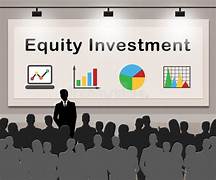Equity Kya Hota Hai: Revealing the Secret || What is Equity in Business & Investing? ||
Equity Kya Hota Hai: Revealing the Secret
|| What is Equity in Business & Investing? ||

Equity Kya Hota Hai: Revealing the Secret || What is Equity in Business & Investing? || Equity, in a financial context, refers to the ownership interest that shareholders hold in a company. It represents the residual value of assets after deducting liabilities. Equity represents the ownership stake that shareholders have in the company’s assets and earnings. Here are some key points to understand about equity:
- Ownership: Equity holders, also known as shareholders or stockholders, own a portion of the company’s assets and have a claim on its earnings and profits.
- Equity in Balancet: On a company’s balance sheet, equity is listed as “Shareholder’s Equity” or “Owner’s Equity.” It’s a key component of the balance sheet’s equation, which states that assets minus liabilities equal equity. Equity Kya Hota Hai: Revealing the Secret || What is Equity in Business & Investing? ||
- Components of Equity: Equity is composed of several elements, including:
- Common Stock: The initial investment made by shareholders in exchange for ownership.
- Additional Paid-In Capital: The amount investors paid for shares over and above their nominal or par value.
- Retained Earnings: Accumulated profits that the company has not distributed to shareholders as dividends.
- Treasury Stock: Shares that the company buys back from shareholders, reducing the number of outstanding shares.
- Stockholders’ Rights: Equity holders typically have certain rights, such as voting rights in corporate decisions, the right to receive dividends, and the right to share in the proceeds if the company is liquidated.
- Market Value: The market value of a company’s equity is determined by the stock price multiplied by the number of outstanding shares. It reflects the collective perception of the company’s value by investors.
- Equity Financing: Companies can raise capital by issuing new shares of stock to investors. This is known as equity financing. It allows companies to raise funds without incurring debt.
- Return on Equity (ROE): ROE is a financial metric that measures the company’s profitability relative to shareholders’ equity. It’s calculated as net income divided by shareholders’ equity.
- Risk and Reward: Shareholders assume both the risks and potential rewards of the company’s performance. If the company does well, shareholders can benefit from capital appreciation and dividends. If the company performs poorly, shareholders may experience losses.
- Equity Markets: Equities are traded on stock exchanges, allowing investors to buy and sell shares in publicly traded companies. The stock market provides liquidity and a platform for investors to trade equities.
- Equity Research: Analysts and investors conduct equity research to evaluate the financial health, performance, and potential of companies. This research assists investors in making informed decisions about buying or selling shares.
Equity Kya Hota Hai: Revealing the Secret || What is Equity in Business & Investing? || Equity is a fundamental concept in finance and investing, and it plays a significant role in both corporate finance and personal finance. It represents ownership and participation in the growth and profits of a company.
Equity investing, also known as stock investing, involves purchasing shares or ownership stakes in publicly traded companies with the aim of generating returns. Equity investors become shareholders and have the potential to benefit from the company’s growth, earnings, and value appreciation over time. Here are the key aspects of equity investing : Equity Kya Hota Hai: Revealing the Secret || What is Equity in Business & Investing? ||
- Ownership: When you buy shares of a company’s stock, you become a partial owner of that company. The number of shares you own determines your ownership stake and your potential claim to the company’s assets and earnings.
- Returns: Equity investors can earn returns through two main channels: capital appreciation and dividends.
- Capital Appreciation: If the company’s stock price increases over time, the value of your investment grows. You can sell your shares at a higher price than what you initially paid, realizing a profit.
- Dividends: Some companies distribute a portion of their profits as dividends to shareholders. Dividends provide regular income to investors.
- Risk and Reward: Equity investing carries both the potential for high returns and the risk of loss. Stock prices can be volatile, and the value of your investment may fluctuate based on various factors, including market conditions, economic trends, and company performance.
- Long-Term Perspective: Successful equity investing often requires a long-term perspective. The stock market can experience short-term fluctuations, but historically, it has shown an upward trajectory over the long run.
- Diversification: Diversifying your equity investments across different industries and companies can help manage risk. Spreading your investments reduces the impact of poor performance by a single company.
- Research: Before investing in equities, it’s important to conduct thorough research. Analyze a company’s financial statements, management team, competitive position, industry trends, and growth prospects.
- Market Indices: Market indices, such as the S&P 500 and the Dow Jones Industrial Average, track the performance of groups of stocks and provide a snapshot of the overall market trends.
- Stock Selection: There are two main approaches to equity investing:
- Active Investing: Involves selecting individual stocks based on research, analysis, and predictions about the companies’ future performance.
- Passive Investing: Involves investing in index funds or exchange-traded funds (ETFs) that track specific market indices. This approach seeks to replicate the overall market’s performance.
- Risk Management: Understanding your risk tolerance and setting clear investment goals are essential. Always invest an amount you’re comfortable with and can afford to hold for the long term. Equity Kya Hota Hai: Revealing the Secret || What is Equity in Business & Investing? ||
- Emotional Discipline: Equity investing can be emotional due to market fluctuations. Staying disciplined and avoiding making impulsive decisions based on short-term market movements is important.
Equity Kya Hota Hai: Revealing the Secret || What is Equity in Business & Investing? || Equity investing offers the opportunity to participate in the growth of established companies and potentially achieve significant returns. However, it’s important to be informed, patient, and well-prepared before entering the world of equity investing.

Equity Kya Hota Hai: Revealing the Secret || What is Equity in Business & Investing? || Equity trading refers to the buying and selling of shares of publicly traded companies in the stock market. It is a process by which investors and traders trade ownership stakes in companies in order to potentially profit from price movements. Here’s a breakdown of key concepts related to equity trading:
- Shares: Shares, also known as stocks or equities, represent ownership in a company. When you buy shares, you become a partial owner of the company and have a claim on its assets and earnings.
- Stock Exchanges: Equity trading takes place on stock exchanges such as the New York Stock Exchange (NYSE) and the Nasdaq. These exchanges provide a marketplace where buyers and sellers can trade shares.
- Buy and Sell Orders: Traders place buy orders to purchase shares at a certain price, and they place sell orders to sell shares at a certain price. When a buy order matches a sell order, a trade is executed. Equity Kya Hota Hai: Revealing the Secret || What is Equity in Business & Investing? ||
- Market Orders vs. Limit Orders: A market order instructs the broker to execute the trade immediately at the current market price. A limit order sets a specific price at which you’re willing to buy or sell, but it’s only executed if the market reaches that price.
- Bid and Ask Prices: The bid price is the price at which buyers are willing to purchase shares, while the ask price is the price at which sellers are willing to sell. The difference between the bid and ask prices is known as the bid-ask spread.
- Day Trading vs. Swing Trading: Day trading involves making multiple trades within a single trading day, aiming to profit from short-term price movements. Swing trading involves holding positions for several days to weeks to capture more significant price swings. Equity Kya Hota Hai: Revealing the Secret || What is Equity in Business & Investing? ||
- Long vs. Short Positions: Taking a long position means buying shares with the expectation that their value will rise. Taking a short position involves borrowing shares and selling them with the expectation that their value will fall, aiming to buy them back later at a lower price.
- Leverage: Some traders use leverage, which involves borrowing money to increase the size of their trading positions. While leverage can amplify gains, it also increases potential losses.
- Technical and Fundamental Analysis: Traders use technical analysis to study price patterns and trends, and fundamental analysis to assess a company’s financial health and prospects before making trading decisions.
- Risk Management: Successful equity trading involves managing risk. This includes setting stop-loss orders to limit potential losses and diversifying your portfolio to spread risk across different stocks.
- Emotional Discipline: Emotional control is crucial in equity trading. Prices can be volatile, and making impulsive decisions based on emotions can lead to losses. Equity Kya Hota Hai: Revealing the Secret || What is Equity in Business & Investing? ||
- Regulation: Equity trading is regulated by government agencies, such as the U.S. Securities and Exchange Commission (SEC) in the United States, to ensure transparency and fairness.
Equity Kya Hota Hai: Revealing the Secret || What is Equity in Business & Investing? || Equity trading can be done by individual investors, professional traders, and institutional investors. It offers opportunities for profit but also carries risks. Traders need to educate themselves, develop strategies, and exercise discipline in their approach to equity trading.

Equity Kya Hota Hai: Revealing the Secret || What is Equity in Business & Investing? || The term “equity stock market” generally refers to the part of the financial market where shares of publicly traded companies are bought and sold. It’s the marketplace where investors and traders engage in equity trading. Here’s a more detailed look at what the equity stock market entails:
- Definition of Terms:
- Equity: As previously discussed, equity refers to ownership in a company in the form of shares or stocks.
- Stock Market: The stock market is a marketplace where buyers and sellers trade shares of publicly listed companies.
- Function: Equity Kya Hota Hai: Revealing the Secret || What is Equity in Business & Investing? || The equity stock market provides a platform for companies to raise capital by issuing shares to the public.
- Investors can buy and sell shares, potentially benefiting from capital appreciation and dividends.
- Components:
- Exchanges: Stock exchanges, such as the New York Stock Exchange (NYSE), Nasdaq, London Stock Exchange (LSE), and others, provide a regulated environment for trading stocks. Different exchanges have their own listing requirements and regulations.
- Listed Companies: Publicly traded companies are listed on stock exchanges, making their shares available for trading to the public.
- Traders and Investors: Individuals, institutions, and traders buy and sell shares based on their investment goals and strategies.
- Market Participants:
- Individual Investors: People who invest their personal funds in stocks.
- Institutional Investors: Organizations like mutual funds, pension funds, and hedge funds that manage large pools of capital.
- Traders: Individuals or firms who buy and sell stocks frequently to profit from short-term price movements.
- Types of Orders:
- Market Orders: Orders to buy or sell shares at the prevailing market price.
- Limit Orders: Orders to buy or sell shares at a specific price or better.
- Market Indices:
- Market indices, like the S&P 500, Dow Jones Industrial Average, and others, track the performance of a specific group of stocks. They serve as benchmarks for the overall market. Equity Kya Hota Hai: Revealing the Secret || What is Equity in Business & Investing? ||
- Market Trends and Sentiment:
- Stock prices are influenced by factors such as company performance, economic data, geopolitical events, interest rates, and investor sentiment.
- Regulation:
- Stock markets are regulated by government agencies to ensure fairness, transparency, and investor protection. In the United States, the U.S. Securities and Exchange Commission (SEC) oversees the securities industry.
- Investor Education and Research:
- Investors often conduct research and analysis on companies before making investment decisions. This can involve studying financial statements, industry trends, and market conditions.
- Risk and Return:
- Investing in the equity stock market carries risks, including the potential for losses. However, historically, the stock market has provided the potential for higher returns compared to many other investment options over the long term.
- Long-Term Perspective :Many experts recommend a long-term investment perspective in the equity stock market to potentially benefit from the market’s historical upward trajectory

Shareholders assume both the risks and potential rewards of the company’s performance. If the company does well, shareholders can benefit from capital appreciation and dividends. If the company performs poorly, shareholders may experience losses. Equity Kya Hota Hai: Revealing the Secret || What is Equity in Business & Investing? ||
Equities are traded on stock exchanges, allowing investors to buy and sell shares in publicly traded companies. The stock market provides liquidity and a platform for investors to trade equities. Equity Kya Hota Hai: Revealing the Secret || What is Equity in Business & Investing? ||
Analysts and investors conduct equity research to evaluate the financial health, performance, and potential of companies. This research assists investors in making informed decisions about buying or selling shares. Equity Kya Hota Hai: Revealing the Secret || What is Equity in Business & Investing? ||
Investing in the equity stock market carries risks, including the potential for losses. However, historically, the stock market has provided the potential for higher returns compared to many other investment options over the long term.
Equity analysis involves the evaluation of publicly traded companies to assess their financial health, growth prospects, and overall investment potential. The goal of equity analysis is to make informed investment decisions by analyzing various factors that can impact a company’s stock value. Here are the main components of equity analysis:
- Fundamental Analysis:
- Financial Statements: Analyze a company’s financial statements, including the balance sheet, income statement, and cash flow statement, to understand its financial position, profitability, and cash flow.
- Ratio Analysis: Calculate and interpret financial ratios like the price-to-earnings (P/E) ratio, price-to-book (P/B) ratio, debt-to-equity ratio, and others to assess valuation, leverage, and efficiency.
- Earnings Growth: Evaluate the historical and projected earnings growth of the company to assess its potential for future profitability.
- Dividend Analysis: Analyze the company’s dividend history and policies, as well as its ability to sustain or increase dividends in the future.
- Industry and Competitive Analysis:
- Industry Trends: Understand the industry in which the company operates, including growth prospects, competitive dynamics, and regulatory factors.
- Competitive Position: Assess the company’s market share, competitive advantages, and positioning within the industry.
- Barriers to Entry: Evaluate the barriers that prevent new competitors from entering the market and challenging the company’s position.
- Management and Governance:
- Management Team: Evaluate the experience and track record of the company’s management team, including the CEO and key executives.
- Corporate Governance: Assess the company’s governance structure, board composition, and adherence to ethical and legal standards.
- Macroeconomic Factors:
- Economic Conditions: Consider the broader economic environment, including factors like interest rates, inflation, and economic indicators that can impact the company’s operations.
- Geopolitical Events: Assess the potential impact of geopolitical events on the company’s operations, supply chain, and market presence.
- Market Sentiment and Technical Analysis:
- Market Sentiment: Evaluate investor sentiment and market expectations about the company’s performance. Positive or negative sentiment can influence stock prices.
- Technical Analysis: Study price charts and technical indicators to identify trends, patterns, and potential entry and exit points for trading.
- Earnings Reports and News:
- Earnings Reports: Analyze quarterly and annual earnings reports, conference calls, and management discussions to understand the company’s financial performance and strategic outlook.
- News and Events: Stay informed about company-related news, announcements, and events that can impact stock prices.
- Valuation Models:
- Equity Kya Hota Hai: Revealing the Secret || What is Equity in Business & Investing? ||
- Discounted Cash Flow (DCF): Estimate the present value of future cash flows to determine the intrinsic value of the company’s stock.
- Comparable Analysis: Compare the company’s financial ratios, growth rates, and other metrics to those of similar companies in the same industry.
Equity Kya Hota Hai: Revealing the Secret || What is Equity in Business & Investing? || Equity analysis requires a combination of quantitative skills, industry knowledge, and a thorough understanding of financial markets. Investors and analysts use a variety of tools and techniques to evaluate companies and make informed investment decisions. Keep in mind that no analysis is foolproof, and markets can be influenced by unpredictable events. It’s important to continue learning and adapting your analysis approach over time. Equity Kya Hota Hai: Revealing the Secret || What is Equity in Business & Investing? ||
